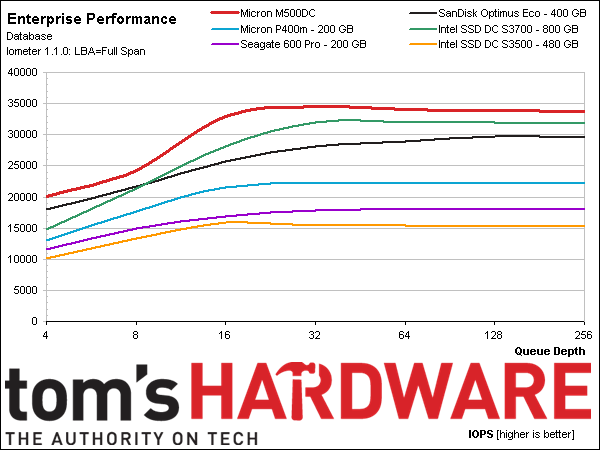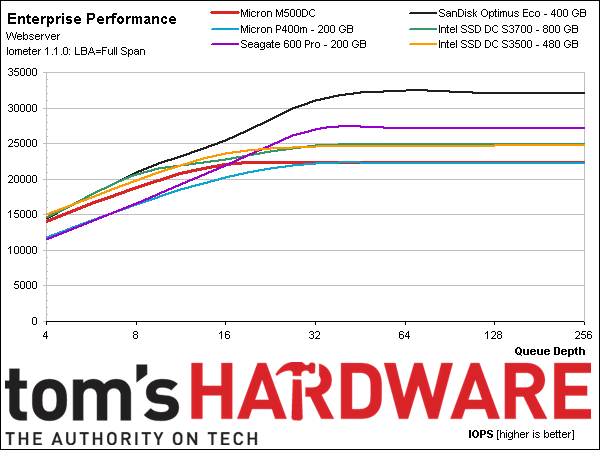Micron M500DC 800 GB SSD Review: Cloud And Web 2.0 Storage
Building on the desktop-oriented M500, Micron is announcing its enterprise-focused M500DC. We got a chance to run the 800 GB model through an updated test suite to gauge whether this Marvell-powered SSD keeps up with the best-known enterprise solutions.
Results: Enterprise Workload Performance
Our next set of tests simulates different enterprise-oriented workloads, including database, file server, Web server, and workstation configurations.
The database workload (also categorized as transaction processing) involves purely random I/O. Its profile consists of 67% reads and 33% writes using 8 KB transfers.
I have to say I was a little surprised at the outcome of this test. Not only does Micron's M500DC blow by the entry-level offerings, but it also maintains a clear advantage over the rest of the field, too. The drive's excellent write performance is enough to make for its lower read rate.
In the file server workload, which consists of 80% random reads of varying transfer sizes, the M500DC gives us another strong showing, only trailing SanDisk's Optimus Eco at high and low queue depths. In the sweet spot (a queue depth between eight and 32), the M500DC is a clear winner.
The Web server workload (100% reads of varying transfer sizes) exposes one of the M500DC's weaknesses: pure read-based transactions. At higher queue depths, it's only able to match the P400m, while trailing the other contenders by a wide margin.
Finally, the workstation benchmark (80% reads, 80% random) puts Micron's M500DC back near the top. While it consistently trails Intel's SSD DC S3700 and SanDisk's Optimus Eco, it clearly beats the rest of the field.
Overall, the M500DC performs well in our mixed workload tests, only falling behind on the read-only metrics. These results should be even higher if we retest using Micron's 240 and 480 GB models. I'd say this is a considerable accomplishment for a drive that owes a lot of its design to a cost-optimized consumer SSD.
Get Tom's Hardware's best news and in-depth reviews, straight to your inbox.
Current page: Results: Enterprise Workload Performance
Prev Page Results: Performance Consistency Next Page Results: Sequential Performance-
ParrLeyne Good article/review!Reply
Only one _small_ problem. According to the Micron product page (http://www.micron.com/products/solid-state-storage/enterprise-sata-ssd/m500dc-enterprise-sata-ssd) the M500DC is a SATA device, not SAS! -
tripleX The author obviously does not understand the subject matter. SAS lumped in with SATA? read-centric SSD isnt meant for read workloads? etc. numerous errors, too many to list.Reply -
tripleX Author does not understand what "corner case" is. corner case testing? are you doing lab validation work?Reply -
drewriley In SSD testing, it is common to call the mix in testing between read/write and random/sequential as '4 corner' or 'corner case' testing. And yes, this is lab verification work, that is kind of the point of the review. Also, SAS and SATA do compete for applications. The point was to put different product that had similar specifications against one another.Reply -
tripleX Reply13279486 said:In SSD testing, it is common to call the mix in testing between read/write and random/sequential as '4 corner' or 'corner case' testing. And yes, this is lab verification work, that is kind of the point of the review. Also, SAS and SATA do compete for applications. The point was to put different product that had similar specifications against one another.
The fact you are claiming this is anything even remotely near lab validation exposes your tremendous lack of knowledge on the subject.
No one refers to 4-corner testing as corner case testing. One link to a reputable site that does so? Instead of arguing an indefensible point you should be attempting to learn exactly what corner case means. Most would have had the good sense to do that before posting.
SAS v SATA is like Formula 1 compared to Go-Karts. Another example of your lack of understanding. SAS is meant for users who require certain features, and the price demands that users are aware of those features. They do not compete against each other, they are two entirely different classes of hardware.
-
tripleX The fact you are claiming this is anything even remotely near lab validation exposes your tremendous lack of knowledge on the subject.Reply
No one refers to 4-corner testing as corner case testing. One link to a reputable site that does so? Instead of arguing an indefensible point you should be attempting to learn exactly what corner case means. Most would have had the good sense to do that before posting.
SAS v SATA is like Formula 1 compared to Go-Karts. Another example of your lack of understanding. SAS is meant for users who require certain features, and the price demands that users are aware of those features. They do not compete against each other, they are two entirely different classes of hardware.



